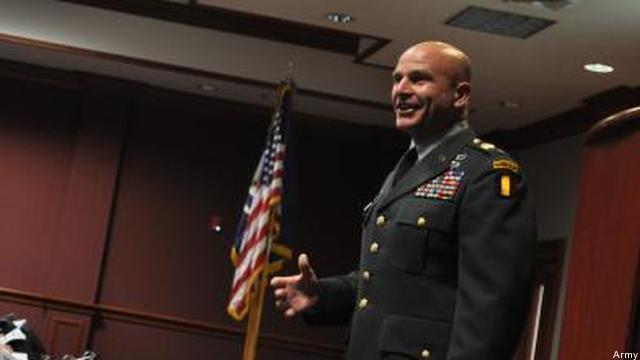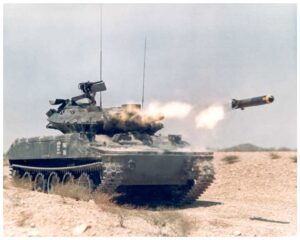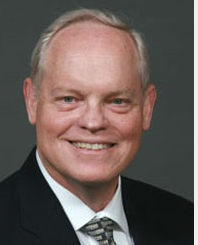Army Changing How It Does Requirements: McMaster
Posted on

Lt. Gen. H.R. McMaster
WASHINGTON: After two decades of procurement disasters, the Army is finally overhauling how it buys new weapons. The service is starting with a difficult test indeed: the new light armored vehicle to provide mobile protected firepower to the 82nd Airborne and other light infantry forces — a role unfilled since the temperamental M551 Sheridan retired in 1997.
Building what’s basically an air-droppable tank has bedeviled the service for decades. Trying to combine firepower, protection, and light weight in a single vehicle helped doom the infamous Future Combat Systems program. Buying something cheap, cheerful, and easy to air-deploy isn’t the solution either, not if it can’t actually survive on arrival.

M551 Sheridan
“It’s not about ‘lean and nimble,'” said Lt. Gen. H.R. McMaster, the intellectually ferocious deputy commanding general of TRADOC, the Army’s Training and Doctrine Command. “Richard Simmons is lean and nimble, but you don’t send Richard Simmons to go fight anybody.”
So there’s a difficult balance to strike between the three words that make up “mobile protected firepower.” The vehicle is still just a concept, not a funded program. But past projects like FCS began going wrong right from those first conceptual stages, when TRADOC Systems Managers (TSMs) wrote up the official requirements for performance with little reference to what tradeoffs would be required in terms of real-world engineering. So what is TRADOC doing differently this time?
“We just did an Initial Capability Document [ICD] for ‘mobile protected firepower,'” said McMaster. “When we wrote that document, we brought together 18th Airborne Corps and other [infantry] and Stryker brigade combat team leadership” — i.e. the units that would actually use the vehicle — “who had recent operational experience.”
So they’re getting help — lots and lots of help. In an organization as bureaucratic and tribal as the Army, voluntarily sharing power is a major breakthrough. It’s especially big for TRADOC, which tends to take on priestly airs as guardian of the service’s sacred doctrinal texts. What TRADOC has done is a bit like the Vatican asking the Bishop of Boise to help draft a papal bull.
But that’s hardly all. “We brought together, obviously, the acquisition community, so PEO Ground Combat Vehicle was in on the writing of the requirements. We brought in the Army lab, TARDEC,” McMaster told reporters at a Defense Writers’ Group breakfast this morning. “We brought in Army Materiel Command and the sustainment community to help write it. And then we brought in the Army G-3 [operations and plans] and the Army G-8 [resources]” from the service’s Pentagon staff.
Traditionally, all these organizations play separate and unequal roles in the process. This time, said McMaster, “we wrote the document together.” That’s the model for how TRADOC will write requirements in the future, he went on: “Do it together and collaborate from the beginning.”
“If it were anyone other than McMaster, I would be skeptical,” said one experienced procurement expert. “He brings a lot of maturity to TRADOC.”
After seeing McMaster’s list of participants, the expert went on, “my first reaction was ‘too many chefs [in the kitchen],’ but if you think how programs get screwed up, it’s because the handoff between requirements and acquisition gets fumbled. I see this as an opportunity to make better-informed decisions — based on cost and technological maturity of the science — part of a program.”
TRADOC’s new process also tries to tie every requirement into the service’s foundational doctrine, the newly issued Army Operating Concept. Traditionally, TRADOC “combat developers” went around “chasing gaps,” McMaster said, trying to find individual shortcomings in Army equipment and then writing a requirement for a fix. Requirements tended to accumulate like Topsy without much of an overarching plan. What big picture thinking there was tended to be divided along the official “warfighting functions” — things such as “mission command,” “fires,” or “intelligence” — which “artificially separate[s] those things that have to be routinely combined in combat,” McMaster said.
Now, instead, TRADOC will develop requirements in response to specific military problems: the 20 “warfighting challenges” laid out in the Army Operating Concept which will now drive wargaming and experimentation. Instead of developing requirements in isolation,” he said, “we’ll be able trace a requirement back to how it helps us fight better.”

Andrew Krepinevich
“General McMaster is focusing on the big picture: at the operational level of war and at enduring challenges for ground forces, as well as new sources of advantage,” said Andrew Krepinevich, head of the influential Center for Strategic and Budgetary Assessments. “That’s all to the good. You have to have an idea of what you are trying to do at the operational level of war in order to inform what is needed at the tactical level. That’s what the general appears to be trying to do: get the Army to think on a higher plane.”
McMaster himself put it more modestly. “What did Aristotle say? ‘Spend your time on what you can affect’?” he said “We’re trying to affect what we can affect, which is the requirements process.”
“A lot of people will complain about the Federal Acquisition Regulation [and] there are changes that Congress I think can advocate for,” he said, “[but] what we can do internally is we can simplify and unify the requirements process.”
It’s important to remember how huge a hole the Army has to climb out of. The 2011 Decker-Wagner report calculated that, since 1996, the Army had wasted from $1 billion to $3 billion annually on two dozen different cancelled programs. The report pointed out an institutional problem much bigger than just the Future Combat System. Indeed, since FCS went down in flames, the Army has cancelled yet another major program, its Ground Combat Vehicle.
While other services have plenty of delays and overruns — the tri-service Joint Strike Fighter comes very much to mind — they usually get their gear eventually — again, consider JSF. The Army has a unique track record of spending billions and getting nothing. One of the Decker-Wagner report’s main culprits was a slow, rigid, and compartmentalized requirements process, something McMaster pledged to fix.
“The Army’s harder. It’s much harder than any other other service,” said McMaster. “An aircraft carrier‘s super complex [and] a nuclear sub is super complex, but you can see that: It’s a certain big tangible thing…and you can say that’s my requirement: the next aircraft carrier, the next sub.” An Army unit, however, has hundreds of independently moving parts — tanks, trucks, rifles, portable generators, command posts — that all have to work together. Thinking in tidy bureaucratic compartments just won’t solve the problem.
Edited 10:45 pm to add discussion of Decker-Wagner report and comparison to other services.
Subscribe to our newsletter
Promotions, new products and sales. Directly to your inbox.
